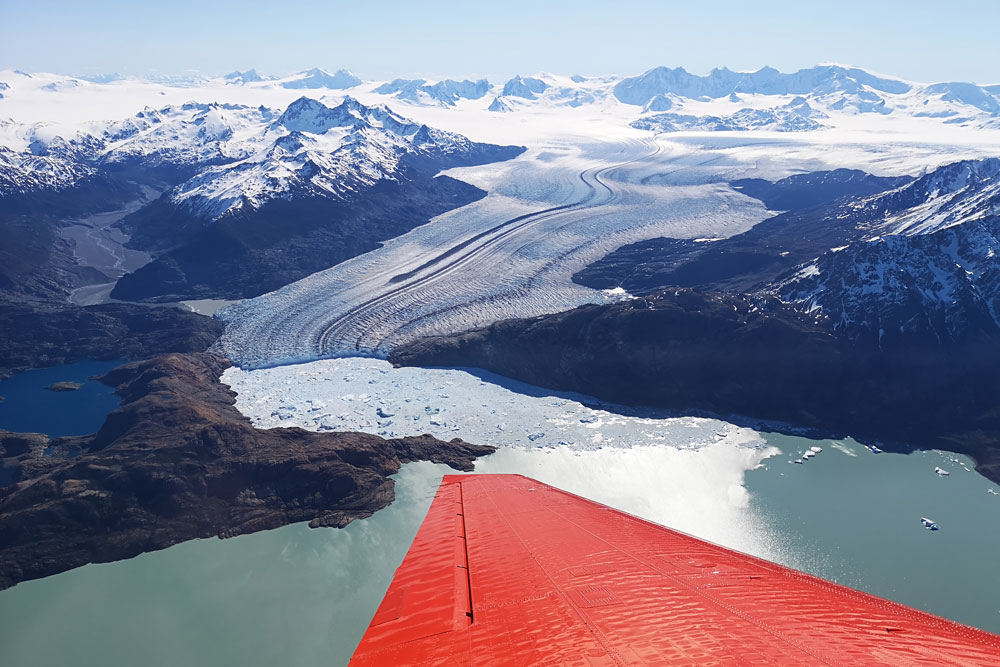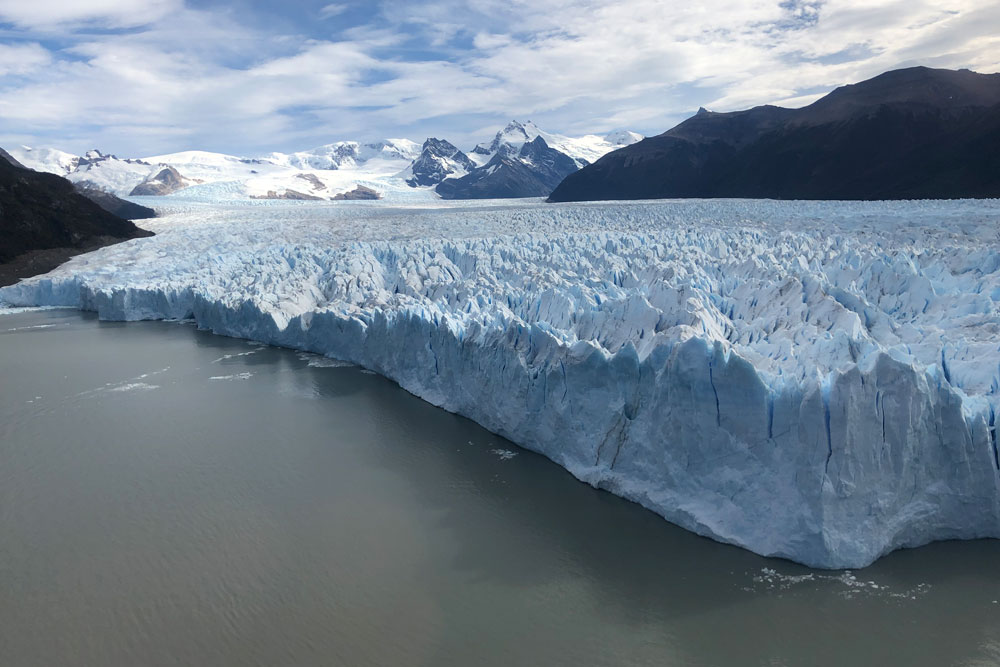Surveying icy landscapes
Icefields in South America are larger than all glaciers in the European Alps together
Although the two huge icefields in the Andes in South America cover approximately 16,000 square kilometers, an area roughly equivalent to the state of Thuringia in Germany, not much is known about the Patagonian icefields. A team led by Johannes Fürst from the Institute of Geography at FAU is trying to change that. Using cutting-edge methods and the rather scarce data available to date, the group re-estimated the volume of both icefields to be 5351 cubic kilometers in 2000. This would mean that the two ice caps have forty times more ice than all the glaciers in the European Alps together. The researchers have published their findings in the journal Communications Earth & Environment (DOI: 10.1038/s43247-023-01193-7)
The Patagonian icefields definitely put Europe’s glaciers in the shade. This becomes clear just by looking at their huge dimensions: the Northern Patagonian Icefield alone is approximately 120 kilometers long and in some places between 50 and 70 kilometers wide. The South Patagonian Icefield is more than three times as large and stretches over an area of approximately 350 kilometers from north to south with an average width of 30 to 40 kilometers. On average, the ice masses there are more than 250 meters thick, making them roughly five times thicker than the glaciers in the European Alps.

This is coupled with an unusual and at times extreme climate. Similarly to Central Europe, the winds in these regions of South America often blow from west to east and carry damp air from the oceans to the interior. The decisive difference lies in the Andes which stretch from north to south in South America, with altitudes ranging from less than 3000 meters in the south and up to 6000 meters in the subtropical and tropical regions, forcing the body of damp air coming from the Pacific to rise. As the air cools down, it is only able to hold less moisture and it begins to rain or snow depending on the altitude and time of year.
The regions between the Pacific coast and the Andes often have more than 3000 millimeters precipitation per year. This means that 3000 liters of rain, snow or hail fall on each square meter of land per year. In comparison, cities such as Nuremberg and Munich only have relatively little precipitation, namely approximately 550 and 930 liters respectively. Thanks to its high levels of precipitation, the sparsely populated area to the west of the Andes in the south of Chile has a generally cool climate where a lush rainforest grows. Rain falls from the clouds in the high altitudes in the mountains and the winds bring relatively dry air to the areas to the east of the Andes. This has given rise to another sparsely populated area, with a bare steppe landscape stretching over hundreds of kilometers.
Both Patagonian icefields are therefore located in a remote region of the world where considerably fewer climate and geographic data are gathered than in Central Europe, for example. In addition, Argentina and Chile have been in dispute over the exact position of the border for a long time now, and they have come to a deadlock over the exact position over the Southern Patagonian Icefield, basically declaring wide stretches of the glacier to be a no-man’s land and making it extremely difficult to access. Not only that, it means that it is virtually impossible to take geographical measurements in situ.

Research in the area is also hindered by a natural phenomenon. Precipitation increases with each meter that the air rises on the western slopes of the Andes. It therefore snows in vast quantities on the summits and on both Patagonian icefields. “We do not know exactly how much precipitation actually falls there, however” explains FAU researcher Johannes Fürst. The large volumes of snow that fall at these high altitudes make it unfeasible to operate a weather station in such a remote location. Any weather station would be susceptible to damage from the massive quantities of snow that fall in the region, and repairs would prove extremely difficult and time-consuming.
No-one can know for sure whether 10,000 or even up to 30,000 liters precipitation fall there per square meter each year. “It is speculated that the maximum snowfall lies between 30 and 100 meters per year,” says Johannes Fürst. “Those are unimaginable quantities.” As the ice of the glacier is formed over time from these masses of snow, accurate figures would allow researchers to gain a better understanding of the processes. One thing is for sure: The huge quantities of precipitation are a reliable and plentiful source of replenishment for the ice cap, with the ice it forms soon also joining the flow down towards the valley.
As a result, the glaciers coming from the Patagonian icefields flow extremely rapidly. While the ice in the European Alps only rarely covers a distance of one hundred meters per year, most of the glaciers in the Patagonian icefields move more rapidly than this. Many of them even flow towards the valley at a rate of more than one kilometer a year, with some even reaching speeds of several kilometers a year. Apart from in Patagonia, speeds like this are only known to be reached by the glaciers of Greenland and the Antarctica – far and away the largest in the world.
According to studies conducted by Matthias Braun from the Institute of Geography at FAU, climate change means on average, the ice in the glaciers in the Patagonian icefields is becoming one meter less thick every year. This is ice loss at a record-breaking scale, and another good reason for keeping a close eye on the Patagonian icefields and using cutting-edge scientific methods to survey them. That is exactly what the FAU-lead team has now done in close collaboration with Chilean research organizations. The group compared the existing, often scarce measurements taken in situ with the considerably coarser satellite data. In this way, they were able to calibrate results from space, allowing for more accurate assessments of the ice thickness in remote regions without data taken in situ.
Another advantage of the method is that researchers can gather data about the ground under the ice. Accordingly, they can estimate much more accurately how quickly a glacier can be expected to disappear in future. For example, the ice may be hiding a hollow in the ground. If the glacier retreats, its meltwater may turn this hollow into a lake. As long as these lakes are in contact with the ice, the relatively warm water can attack the glacier from below. This can lead to more ice breaking off from the ice front and accelerate the retreat of the glacier even further.
The FAU glaciologists therefore have good reasons for measuring the Patagonian ice cap in situ. They fly over the glacier with a helicopter and use radar beams to measure the depth of the ice to within a few meters. This leads to a considerable improvement in the data available on this extremely dynamic ice. Data like this is extremely important for climate research, as rising temperatures are causing the Patagonian icefields to lose ice at an alarming rate. As each meter driven in a petrol or diesel powered car leads to one sugar cube of glacier ice melting, Johannes Fürst intends keeping a close eye on these icefields in order to be able to keep track of dangerous developments more closely than has been possible until now.
More information
https://www.nature.com/articles/s43247-023-01193-7
Dr. Johannes Fürst
Institut für Geographie
Tel.: 09131/85-26680
johannes.fuerst@fau.de
